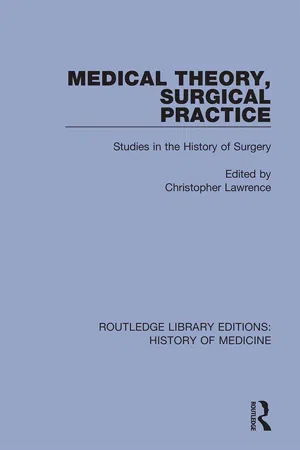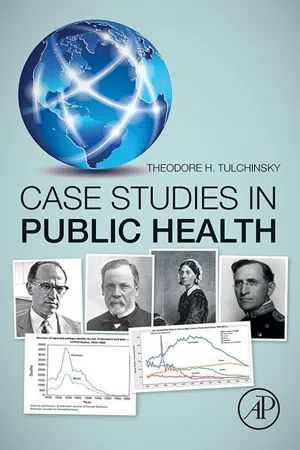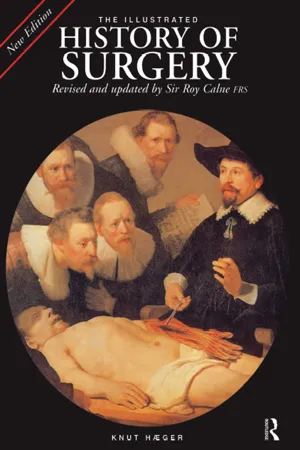Biological Sciences
Joseph Lister
Joseph Lister was a British surgeon who is known for pioneering antiseptic surgery. He introduced the use of carbolic acid (phenol) as a disinfectant during surgical procedures, significantly reducing the risk of infection and improving surgical outcomes. Lister's work laid the foundation for modern antiseptic practices and had a profound impact on the field of surgery.
Written by Perlego with AI-assistance
Related key terms
4 Key excerpts on "Joseph Lister"
- eBook - ePub
Medical Theory, Surgical Practice
Studies in the History of Surgery
- Christopher Lawrence(Author)
- 2018(Publication Date)
- Routledge(Publisher)
6Practising on principle: Joseph Lister and the germ theories of disease
Christopher Lawrence and Richard DixeyAntiseptic surgery is simply a struggle with the causes of putrefaction. I have not mentioned the germ theory of infective disease at all. That has no essential bearing on the principles of antiseptic surgery. (William Watson Cheyne, 1882)IntroductionJoseph Lister’s antiseptic system of surgical treatment was developed over a period of about thirty-five years between 1865 and 1900. From a variety of more or less critical perspectives, Lister’s theory and practice have been regarded as the foundations on which were built modern aseptic surgery and the conceptual framework deemed inseparable from it, the germ theory of disease. Versions of this story are well known to medical historians and, indeed, to a more general audience, and will be assumed in what follows. Here we argue that a crucial dimension of Listerian surgery has been ignored by historians: the pathological theories employed by Lister and his most important collaborator and publicist, William Watson Cheyne. Investigation of this limited area, we suggest, reveals the history of antiseptic surgery in a new light and demonstrates that many of the practical and theoretical origins of aseptic surgery were not Listerian. That the origins of aseptic surgery lie in non-Listerian traditions has been suggested by other authors.1 None, however, has explored the means by which the Listerians were so successful in representing their work as the sole legitimate precursor of modern surgery.2 The correct reconstruction of Lister’s pathological theories makes this possible. It also makes it possible to write the history of late Victorian surgery as a malleable cultural form, not as a practice whose details were determined by biological agents.Recovering Lister’s pathological theories is not an exercise in reconstructing an ossified body of ideas employed by Lister throughout his life. Although there are continuities, Lister continually modified his views. He did, however, always maintain that surgery was only practised properly when it was based on true, scientifically ascertained, pathological principles. This view, if not unusual at the time, was by no means universal. In the late 1860s Lister justified his practice by reference to a germ theory of putrefaction. By the mid-1870s this theory had been elaborated into a comprehensive account of the putrefactive origins of epidemic disease. At this time Lister invoked Pasteur’s experiments as the inspiration for the theory and practice of antiseptic surgery. In the late 1870s and early 1880s Lister and Cheyne began to remould their views in the light of the new, and quite different, German germ theory of infective disease. At first they subordinated German views to their putrefactive theory then, around 1880, the theory of infection was given equal and independent status. Finally, in the mid-1880s, putrefaction was subordinated to a germ theory of infection. In these years the experiments of German workers, notably Robert Koch, were increasingly cited as the basis of the theory and practice of antiseptic surgery. Theory and practice by now were both very different from their originals. In 1867 Listerian practice was directed to creating local conditions such that severe wounds involving bone damage might heal by granulation or by organisation in a clot. During the late 1870s and 1880s Listerians increasingly absorbed the techniques of their critics, such that, by 1900, most surgical practice was centred on the creation of a general environment in which such wounds might heal by simple apposition of their edges (first intention healing). Lister’s early ideas and practice, therefore, were by no means like his later ones, and the change from the one to the other was complex and contingent, not simple and necessary. Nevertheless by the 1890s Listerians could represent the practice of aseptic surgery which was based on the, by now recognisably modern, germ theory of infection, as deriving from a simple elaboration of early Listerian ideas and practice. - eBook - ePub
- Theodore H. Tulchinsky(Author)
- 2018(Publication Date)
- Academic Press(Publisher)
Joseph Lister (1827–1912), was born in Upton, England. He studied at University College in London and received his Bachelor of Arts degree in 1847, and in 1852 his Bachelor of Medicine with honors. He became a fellow of the Royal College of Surgeons and a house surgeon at University College Hospital. He moved to Edinburgh, Scotland, in 1853 to study surgery at the Edinburgh Royal Infirmary and began his surgical practice. He became concerned with the tremendous mortality rates associated with surgical and traumatic wounds. In 1856, he traveled to Vienna and met with former colleagues of Semmelweis. He became motivated to seek ways to apply their ideas for safe obstetrics to surgical practice. Lister became a professor of surgery at the Royal Infirmary in Glasgow in 1860. In 1864, Louis Pasteur delivered his world-changing paper on fermentation and spoilage of beer, wine, and milk caused by micro-organisms and a description of methods for eliminating micro-organisms by exposure to heat or chemical solutions.Lister heard of Pasteur's work on putrefaction in 1865, and realized the applicability of the Germ Theory to surgical practice. He tested “antiseptic” techniques to prevent wound infections. In 1867 he published a series of articles in Lancet, including his first study comparing morbidity and mortality between simple and compound fractures—i.e., those with unbroken skin versus those with bones protruding through an opening in the skin. The first report entitled, “On a New Method of Treating Compound Fractures, Abscesses etc. with Observation on the Condition of Suppuration.” This led to his growing conviction of the need for antisepsis including sterilizing instruments, carbolic acid, hand-washing, and clean dressings for safer surgical practice. He sought to improve antiseptic techniques and adopted the use of carbolic acid (phenol) to “sterilize” surgical instruments inspired by phenol’s previous use to treat sewage which had resulted in a reduction in diseases in Carlisle, England. Lister’s 1867 publication “On the Antiseptic Principle in the Practice of Surgery - eBook - ePub
- Sir Roy Calne(Author)
- 2018(Publication Date)
- Routledge(Publisher)
Another renowned German surgeon, Richard von Volkmann (1830–89) in Halle, had so much gangrene at his hospital—as well as erysipelas, an acute skin inflammation—that he was ready to shut it down until he tried Lister’s method. Instantly things improved: he treated 75 open fractures without a single death, and only four out of 139 amputees died, results to be proud of even today. Equally good news appeared elsewhere, and Lister was glorified at the great congress of surgeons in Berlin in 1875. This led to an invitation and, later that year, he made a tour of triumph to Berlin, Munich and Leipzig, also becoming the first honorary member who was admitted to the German surgical association.The carbolic-acid technique, called “Listerism” as often as “antisepsis”, had further champions whom we shall meet—Billroth in Vienna, and Bassini (famous for describing a method of hernia repair which is still used) in Italy. But it was delayed in the United States and Canada, although Marion Sims and William Halsted understood its value quickly. Halsted encountered so much opposition that he had to operate in a tent in the garden of Bellevue Hospital in New York, as his colleagues hated the fumes of carbolic acid. Listerism was also modified by using disinfectants such as iodine instead of carbolic acid.Among the first to accept Listerism was Ernst von Bergmann (1836–1907). In the Franco-Prussian War, he had experimented with what he called “aseptic” bandages, but he gave them up for carbolic acid. Since this irritated the skin even in pure form, he replaced it with a solution of bichloride of mercury, on the advice of Robert Koch. Then he abandoned this in favour of carefully cleaning the operating theatre, surgeon and patient—as well as sterilizing the instruments in steam. The latter procedure was probably first tried by Lister himself, yet rejected for fear that the “human factor” would find it too complicated!Thus antisepsis, or defence against bacteria, gave way to asepsis—the complete elimination of bacteria—which is the method we follow. Ironically, the opponents of antisepsis had become its firm advocates, and now opposed asepsis. Lucas-Championnière, Lister’s first supporter in France, denounced Bergmann’s disciples as a “bandwagon of infidels”, citing Lister: “It is safer to use an antiseptic…” Like-wise, Americans continue to worship the great man’s name in that of a mouthwash, Listerine. - eBook - ePub
Seeking the Cure
A History of Medicine in America
- Ira Rutkow(Author)
- 2010(Publication Date)
- Scribner(Publisher)
8 The matter-of-fact Lister even demonstrated antiseptic techniques on an actual patient and later displayed an atomizer used to spray an antiseptic solution on a wound and throughout the air of an operating room.For many, Lister’s talk was an unqualified triumph. “Modesty is stamped upon his every act and word,” wrote an eyewitness to Lister’s performance, “and he does believe in antiseptic surgery.”9 The reporter for the prominent Boston Medical and Surgical Journal declared that “the great event of the day was the discourse by Professor Lister.”10Lister’s doubters, however, dotted his audience as well, and many were upset with the length of his talk. As strange as it sounds today, physicians in the pre-Listerian era regarded the presence of pus as desirable. They believed wounds to be lined with dead tissue that needed to be expelled in the form of purulent matter. When an injury healed without an abundant flow of what was termed “healthy” or “laudable” pus, doctors considered it a medical aberration. Hamilton pointed out that there were other popular methods for treating wounds as well, “for which their advocates have made special claims, all of which may be considered as contending with the method advocated by Prof. Lister, for respectful consideration, if not for preference.”11At the Congress’s Friday-night closing banquet, Lister sat next to Samuel Gross, the esteemed American surgeon, who was president of the Congress and the subject of the Eakins painting that hung in the main hall. Gross had recently penned a celebratory essay praising the contributions of American physicians to the art of surgery. As a finishing aside in his article, he quipped, “Little, if any, faith is placed by any enlightened or experienced surgeon on this side of the Atlantic, in the so-called treatment of Professor Lister.”12
Learn about this page
Index pages curate the most relevant extracts from our library of academic textbooks. They’ve been created using an in-house natural language model (NLM), each adding context and meaning to key research topics.



